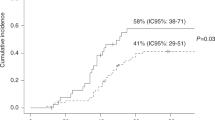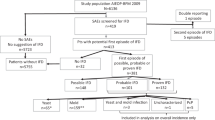Summary:
Caspofungin (CAS) is the first of a new class of antifungal agents, the echinocandins, that interfere with fungal cell wall synthesis by inhibition of glucan synthesis. Here, we report the results of 31 patients treated with CAS following allogeneic SCT. CAS was administered as a second-line agent to patients with invasive fungal infection (IFI) (n=15) or fever of unknown origin (n=16) who were recalcitrant to or intolerant of prior antifungal therapy. Unsuccessful first-line regimes included amphotericin B (n=17), liposomal amphotericin B (n=5), fluconazole (n=3), itraconazole (n=1), and voriconazole (n=2). All patients received concomitant immunosuppressive therapy for graft-versus-host disease. In 23 patients, cyclosporin A (CSA) and CAS were administered concurrently without any major side effects detected. Observed increases in GPT were not clinically significant. Normalization of serum creatinine and significant reductions in C-reactive protein were observed in response to CAS. Favorable outcome to CAS were documented in eight of 15 patients with IFI and in 15 of 16 patients with fever of unknown origin. CAS is a promising alternative in patients with IFI and fever of unknown origin in the setting of allogeneic SCT.
This is a preview of subscription content, access via your institution
Access options
Subscribe to this journal
Receive 12 print issues and online access
$259.00 per year
only $21.58 per issue
Buy this article
- Purchase on Springer Link
- Instant access to full article PDF
Prices may be subject to local taxes which are calculated during checkout
Similar content being viewed by others
References
Groll AH, Walsh TJ . Potential new antifungal agents. Curr Opin Infect Dis 1997; 10: 449–454.
Andriole VT . Current and future antifungal therapy: new targets for antifungal agents. J Antimicrob Chemother 1999; 44: 151–162.
Wingard JR, Leather HL . Empiric antifungal therapy for the neutropenic patient. Oncology 2001, 351–361.
Chiou CC, Groll AH, Walsh TJ . New drugs and novel targets for treatment of invasive fungal infections in patients with cancer. Oncologist 2000; 5: 120–235.
Cannon JP, Garey KW, Danziger LH . A prospective and retrospective analysis of the nephrotoxicity and efficacy of lipid-based amphotericin B formulations. Pharmacotherapy 2001; 21: 1107–1114.
Walsh TJ, Hiemenz JW, Seibel NL et al. Amphotericin B lipid complex for invasive fungal infections: analysis of safety and efficacy in 556 cases. Clin Infect Dis 1998; 26: 1383–1396.
Graybill JR . The echinocandins, first novel class of antifungals in two decades: will they live up to their promise? Int J Clin Pract 2001; 55: 633–638.
Kurtz MB, Douglas CM . Lipopeptide inhibitors of fungal glucan synthase. J Med Vet Mycol 1997; 35: 79–86.
Stone EA, Fung HB, Kirschenbaum HL . Caspofungin: an echinocandin antifungal agent. Clin Ther 2002; 24: 351–359.
Arathoon EG, Gotuzzo E, Noriega LM et al. A randomized, double-blind, multicenter study of caspofungin versus amphotericin in the treatment of oropharyngeal and esophageal candidiasis. Antimicrob Agents Chemother 2002; 46: 451–457.
Sable CA, Nguyen B-YT, Chodakewitz JA, DiNubile MJ . Safety and tolerability of caspofungin acetate in the treatment of fungal infections. Transplant Infect Dis 2002; 4: 25–31.
Villanueva A, Arathoon EG, Gotuzzo E et al. A randomized double-blind study of caspofungin versus amphotericin for the treatment of candidal esophagitis. Clin Infect Dis 2001; 33: 1529–1535.
Villanueva A, Gotuzzo E, Arathoon EG et al. A randomized double-blind study of caspofungin versus fluconazole for the treatment of esophageal candidiasis. Am J Med 2002; 113: 294–299.
Maertens J, Raad I, Petrikkos G et al. Update of the multicenter noncomparative study of caspofungin (CAS) in adults with invasive aspergillosis (IA) refractory (R) or intolerant (I) to other antifungals: an analysis of 90 patients. 42nd Interscience Conference on Antimicrobial Agents and Chemotherapy, September 27–30, San Diego, CA. Poster M-868, 2002.
Cancidas™ [package insert]. Merck & Co., Inc.: Whitehouse Station, NJ, 2001.
Mora-Duarte J, Robert Betts R, Rotstein C et al. Comparison of caspofungin and amphotericin B for invasive candidiasis. N Engl J Med 2002; 347: 2020–2029.
Singh N . Trends in the epidemiology of opportunistic fungal infections: predisposing factors and the impact of antimicrobial use practices. Clin Infect Dis 2001; 33: 1692–1696.
Sobel JD . Practice guidelines for the treatment of fungal infections. Clin Infect Dis 2000; 30: 652.
Author information
Authors and Affiliations
Corresponding author
Rights and permissions
About this article
Cite this article
Trenschel, R., Ditschkowski, M., Elmaagacli, A. et al. Caspofungin as second-line therapy for fever of unknown origin or invasive fungal infection following allogeneic stem cell transplantation. Bone Marrow Transplant 35, 583–586 (2005). https://doi.org/10.1038/sj.bmt.1704859
Received:
Accepted:
Published:
Issue Date:
DOI: https://doi.org/10.1038/sj.bmt.1704859
Keywords
This article is cited by
-
Recent Studies on Invasive Fungal Diseases in Children and Adolescents: an Update
Current Fungal Infection Reports (2014)
-
Drug interactions and adverse events associated with antimycotic drugs used for invasive aspergillosis in hematopoietic SCT
Bone Marrow Transplantation (2010)
-
Reduced-toxicity conditioning with treosulfan, fludarabine and ATG as preparative regimen for allogeneic stem cell transplantation (alloSCT) in elderly patients with secondary acute myeloid leukemia (sAML) or myelodysplastic syndrome (MDS)
Bone Marrow Transplantation (2006)



